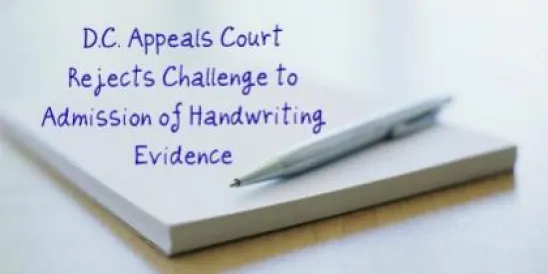If there was ever an open question as to whether forensic handwriting identification is admissible under D.C.’s common law of evidence, the D.C. Court of Appeals has finally put that question to rest. On February 9, 2012, the Court of Appeals held that handwriting comparison and identification, as practiced by FBI examiners, passes the Frye test for admissibility.
The issue arose after Robert Pettus’ jury trial in D.C. Superior Court. Pettus was convicted of sexual assault and first-degree felony murder in 2008 and sentenced to 60 years in prison. The conviction rested in part on multiple forms of forensic evidence, including DNA, fiber, fingerprint and handwriting identification evidence. With regard to the handwriting analysis, FBI document examiner Hector Maldonado testified that Pettus authored a handwritten note left at the crime scene. The note on the victim’s body read, “You s[h]ould[’]n[t] have cheated on me.” After comparing the note with 235 pages of writing taken from Pettus’ jail cell, Maldonado concluded that Pettus wrote the note. According to Maldonado, the writings exhibited “an overwhelming amount of handwriting combinations . . . in agreement with each other” and no significant differences.
Months after Pettus was sentenced, the National Research Council issued a report that critiqued forensic science, including handwriting analysis, and made recommendations for ensuring greater quality and consistency in the field. The report seemed to give Pettus’ case new life.
On appeal, the defense argued that Maldonado’s opinion evidence was inadmissible under D.C. law because the scientific community does not accept conclusive identification based on handwriting analysis. The 2009 NRC report concluded, “With the exception of nuclear DNA analysis, . . . no forensic method [of ‘matching’] has been rigorously shown to have the capacity to consistently, and with a high degree of certainty, demonstrate a connection between evidence and a specific individual or source.”
The Court of Appeals was not persuaded. D.C. law requires only general acceptance of the method, not of the conclusions drawn from it, and general acceptance does not mean unanimous approval. Handwriting analysis has been generally accepted under D.C. law for nearly a century. As such, it is presumptively reliable and, thus, generally admissible. To prove that Maldonado’s handwriting analysis was inadmissible, the defense had to show that there was significant opposition to the technique within the scientific community. The defense failed to meet its burden on appeal, just as it had during the initial pretrial admissibility hearing below.
The Court of Appeals reviewed the evidence proffered at the pretrial hearing and concluded that the prosecution’s evidence for admissibility outweighed the defendant’s evidence for exclusion. The prosecution presented testimony and published studies by three forensic experts. The first witness, an FBI supervisory document analyst, testified that there are well-established regional and national professional organizations for forensic document examiners. She also testified about the methods, professional standards, publications, and university programs in the field.
The prosecution also proffered studies by two university professors that showed empirical evidence of reliability. Multiple studies published by Drexel University professor Moshe Kim showed significantly lower error rates among professional document examiners as compared to trainees and laypersons. SUNY professor Sargur N. Srihari published multiple studies showing that computers can match handwriting samples to their authors with 96 to 98 percent accuracy. Srihari testified further that he could validate handwriting individuality with 95 percent confidence.
By contrast, the defense proffered one non-expert, an evidence professor from Seton Hall University Law School. Professor Mark Denbeaux had co-authored a 1989 law review article urging courts to prohibit the use of handwriting analysis. But his article relied in part on disavowed test data. At the pretrial hearing, Denbeaux contended that Srihari’s 95 percent confidence level did not support a general acceptance of positive identification based on handwriting analysis. In fact, Denbeaux pointed out, Srihari testified to a 5 percent error rate that neither he nor his computer could explain.
The Court of Appeals held that, taken as a whole, the prosecution’s evidence proved that forensic handwriting identification is sufficiently established to have gained general acceptance under Frye. And while the 2009 NRC report was hardly an unqualified endorsement of handwriting analysis, it also did not provide evidence that the science community opposes it as a whole. If a particular examiner’s conclusions are shaky, the answer is not exclusion. Such evidence is best attacked through “vigorous cross-examination, presentation of contrary evidence, and careful instruction of the burden of proof,” the court said.



 />i
/>i

